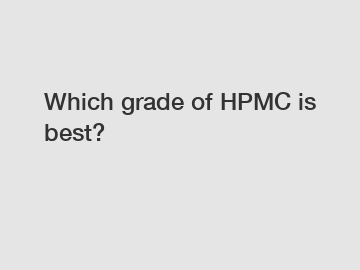Which grade of HPMC is best?
Which grade of HPMC is best?
HPMC, also known as Hydroxypropyl Methylcellulose, is a widely used additive in various industries such as pharmaceuticals, construction, and food. It is known for its versatility and excellent properties, including its abilities to act as a thickener, binder, emulsifier, and film-former. However, with the availability of different grades of HPMC in the market, choosing the right one for specific applications can be a daunting task. In this article, we will explore the various grades of HPMC and discuss which grade might be best suited for different purposes.
1. Understand the different grades of HPMC:

HPMC is available in different grades, each having its unique characteristics. The grades primarily differ in terms of the viscosity range and percentage of methoxy and hydroxypropoxy groups. The lower the methoxy content, the higher the gel point temperature and water solubility.
2. Evaluating viscosity requirements:
Viscosity is a key consideration when selecting the grade of HPMC. It determines the thickness and flow behavior of solutions or gels formed using HPMC. The viscosity of HPMC is usually measured using a viscometer. Different applications may require different viscosities, and choosing the right grade is crucial to achieve desired results. For instance, low viscosity grades are ideal for coatings, while high viscosity grades are suitable for thickening applications.
3. Consideration of solubility:
HPMC offers a range of solubilities depending on the degree of substitution. The solubility of HPMC can affect the dissolution rate of tablets, film formation, and the properties of various solutions. If fast dissolution is required, grades with lower methoxy content should be preferred.
4. The impact of substitution ratio:
The substitution ratio of HPMC refers to the number of hydroxypropoxy and methoxy groups present in the cellulose chain. It affects the gel formation and film-forming properties of HPMC. Higher substitution ratios enhance the gelling properties, making them useful for controlled-release drug delivery systems. On the other hand, lower substitution ratios offer improved water solubility.
5. Compatibility with other additives:
HPMC is often used in combination with other additives such as plasticizers, surfactants, and crosslinking agents. Compatibility between HPMC and other additives is essential to ensure the stability and performance of the final product. It is advisable to conduct compatibility tests when formulating complex systems to determine the best grade of HPMC for compatibility.
6. Regulatory and safety considerations:
When choosing the grade of HPMC, it is crucial to consider regulatory requirements and safety considerations. Certain grades of HPMC may have specific regulatory clearances or limitations for use in pharmaceutical or food applications. Understanding these regulations is important to ensure compliance and product safety.
In conclusion, the choice of the best grade of HPMC depends on the specific requirements of the application. Factors such as viscosity, solubility, substitution ratio, compatibility with other additives, and regulatory considerations play essential roles in determining the right grade. It is advisable to consult with experts or HPMC manufacturers to assist in selecting the most appropriate grade for a particular application. By carefully evaluating these factors, one can make an informed decision and harness the full potential of HPMC for optimal results. Whether it is for pharmaceutical formulations, construction materials, or food products, choosing the right grade of HPMC can make a significant difference in the final outcome.
If you want to learn more, please visit our website Redispersible polymer powder advantages, Polycarboxylate Superplasticzer for Grouting, Flexible Polymer Powder for Wall Putty.

Comments
0